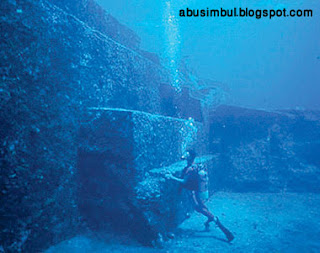Will read together in this article :
Cleopatra, Ptolemy, Caesar, Mark Antony,
Cleopatra ñ perhaps the most famous and romantic woman of antiquity ñ enticed Franck Goddio beneath the waves of the Mediterranean. "More than anything else, it was the drama of Cleopatra life and loves that drew me to Alexandria."
As the French archaeologist and his team explored the underwater city, Goddio exulted: "We were touching stones and columns and thinking Cleopatra had touched them." Cleopatra VII was Egypt's last pharaoh. She ruled and plotted, and loved two of the world's most powerful men from 51 to 30 B.C., a turbulent time of violence and chaos. And Cleopatra's role was not inconsequential.
She was a Ptolemy, heiress to a dynasty that traced its lineage to the Greeks of Alexander the Great, who had conquered Egypt and founded Alexandria in 331 B.C. The rich, cosmopolitan city became a hub of commerce and the heart of science and learning. Its library was said to contain 700,000 volumes - 10 times the number in all of Europe before the printing press. It held such knowledge that its partial destruction in A.D. 391 helped plunge Europe into the Dark Ages. Alexandria's mighty lighthouse was among the Seven Wonders of the Ancient World.
By Cleopatra's time, Egypt was controlled by Rome but was granted a nominal independence, largely because the Empire feared so rich a nation might put too much power in the hands of a Roman governor. Cleopatra's short life was dedicated to maintaining that independence.
The dynasty that ruled Egypt was a murderous clan. The crown went to the survivor of each generation’s bloodbath. Cleopatra's three sisters and two brothers died on her way to becoming - and remaining - Queen of the Nile at age 18. The siblings simply killed each other off: Cleopatra herself had a sister killed and probably a younger brother.
Amid this brutal sibling rivalry, Cleopatra allied herself with Julius Caesar, who had himself emerged from years of civil wars as emperor of Rome. Caesar was her protector and lover - until his murder in 44 B.C. Caesar's death threw Rome into a new round of warfare and left Cleopatra with no one to save her throne. Enter Mark Antony, a prime pretender to the Roman crown. Their love affair became the scandal of the empire. He divorced his Roman wife, Octavia, and married Cleopatra. They basked in the splendor of Alexandria and had three children. Then Octavian unleashed his legions. After years of subtle plots and political skirmishes to stifle his adversaries, Octavian, brother of Antony's spurned wife, demanded title to the Roman Empire. His navy defeated Antony and Cleopatra's royal fleet at Actium in 31 B.C. And the love affair of the ages was over. Antony fell on his sword. Cleopatra invited the fatal bite of an asp. Octavian became emperor of Rome, killed Cleopatra's beloved son, Caesarion, and annexed Egypt to his empire.
But history never forgot Cleopatra.
And as historians dig beneath the legend of the temptress, a very different woman emerges: an intelligent and well-educated ruler who was the first of the royal line to learn the language of her Egyptian subjects; a shrewd and visionary diplomat who used every means to hold her nation and power in a time of brutal chaos; and, of course, a woman who so enchanted at least two legendary womanizers that they accepted dangerous scandal as the price of her company.
This was the woman Goddio was seeking. With assistance of the Egyptian Supreme Council for Antiquities and with funding from the Hilti Foundation of Lichtenstein and the Discovery Channel, he began brushing away the centuries to map and excavate the royal harbor.
He first tested the waters off Egypt in 1984, as part of a team of divers under Jacques Dumas who explored the wreckage of Napoleon’s fleet, which was sunk in the 1798 Battle of the Nile. Dumas told Goddio of the wonders that hid beneath 20 meters (66 feet) of ocean in Alexandria harbor.
Goddio returned in 1992, after winning permission to explore the harbor and map the archaeology of its seabed. The starting point, for almost anyone studying ancient Alexandria, is the work of Strabo, a prodigious Greek geographer who, within the decade following Cleopatra's death, spent five years describing and mapping the city.
Strabo reported a promontory, Cape Lochias, that held a royal palace flanked by others on the nearby mainland. He described a small island, Antirhodos, in the port with a grand palace and a small, private harbor of its own. And he placed Antony's residence at the end of an elbow-shaped breakwater that reached out into the harbor.
That splendor is long gone from the surface. The region is plagued with earthquakes and the tidal waves they often spawn. The tremors toppled the last remnants of the fabled lighthouse in the fourteenth century. Most of the original royal harbor had disappeared into the Mediterranean much earlier - but slowly, with none of the
drama that marked the halcyon days of Cleopatra and Mark Antony. The shifting, tectonic earth simply subsided, gradually submerging the wealth and glory of the Ptolemic pharaohs
If I benefited from this information Subscribe to the RSS feed.




Why not build a wall... and pump the water out once and for all...
ReplyDelete